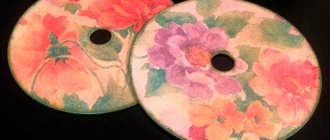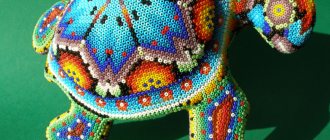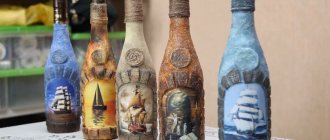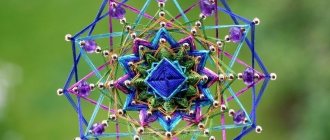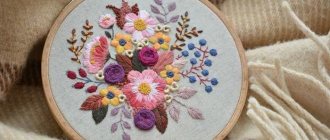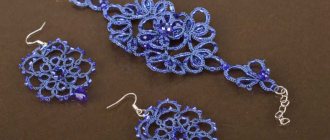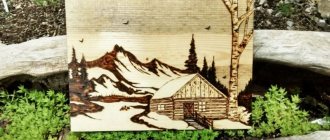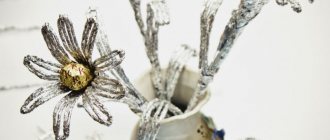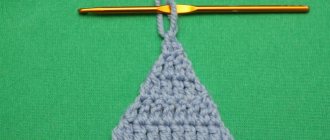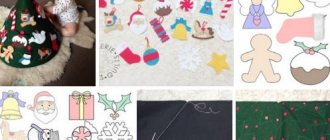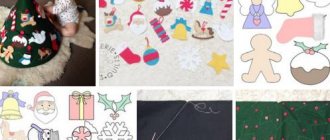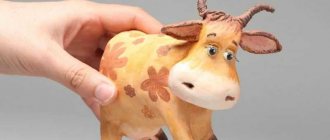Isothread is an unusual type of embroidery, the distinctive feature of which is the surface on which the threads are embroidered. Instead of classical canvas, this art uses thick cardboard or paper.
Using thread graphics, they create beautiful panels and paintings, make bookmarks, decorate boxes and brooches, as well as elements of clothing and interior decor.
The history of the appearance of isothread, and how this activity is useful
Isothread is an applied art in which an image is created on a dense, solid base using threads. Therefore, Isothread has other names, such as: thread design, thread graphics or thread graphics.
The art of string art supposedly appeared in the 16th century in England. To create patterns on fabric, English weavers came up with the following method: they pulled threads in all possible ways onto nails driven into boards. Thus, unusual elegant products were obtained that decorated English houses. It is believed that this is how the art of String Art was born - creating paintings and images using threads and nails.
After some years, this art was improved: instead of planks, paintings began to be made on a different dense surface (mostly cardboard) with a dot pattern previously applied to it in a certain order.
Creating a thread pattern gives its author manual dexterity and perseverance, and also promotes mental and aesthetic development.
First, you need to come up with the drawing itself or find an image, and then analyze the structure and techniques for executing the elements of the image, and then select the optimal color scheme for the base and the threads themselves.
Compiling a pattern from such geometric elements as an arc, circle or angle forms abstract and creative thinking, this is especially useful for children, because all this broadens the horizons of a young thread creator.
A little history
The birthplace of this amazing technique is considered to be medieval England, and the direct authors were craftsmen who made decorative panels to decorate interiors on wooden boards using nails, which were holders for threads stretched in a certain order. With the help of simple manipulations, amazing thread paintings were created, reminiscent of graphic ink drawings.
Over time, the popularity of such works decreased somewhat. A new surge of interest in technology came in the 21st century, when modern craftswomen, skillfully adapting basic techniques, began to create thread paintings on paper and cardboard.
Some masters have expanded the range of materials used, starting to create paintings on leather and plastic, using isona filament in the design of diaries, bags and cosmetic bags, and interior items.
Isothread is a type of embroidery
Drawing a parallel between Isothread and classical embroidery, it becomes obvious that Isothread is a unique type of embroidery, but only on cardboard or paper. This is explained by the fact that a simple “thread step” or also called a chord in Isothread is the same straight stitch in embroidery.
Note that Isothread is not only an intricacy of multi-colored threads. String graphics have their own basic techniques (this will be discussed below). It is these special techniques that are also used in embroidery on fabric.
With their help you can embroider amazing works:
Flowers are embroidered using Isothread techniques
Chamomile field in the form of a pattern
Three basic Isothread techniques are used here: circle, arc and angle
An apple with a quatrefoil inside combines cross stitch and Isothread elements
Decorating the box with embroidery
Fabulous! The circle and angle elements were used again
The corner element forms an embroidered square
Schemes for beginners
A small selection of embroidery and thread patterns for beginners, which are presented below, will help you step by step to create interesting pictures on various topics.
Materials and tools
Embroidery base
In order to start embroidering using the Isothread technique, you first need to think about the basis on which the thread image will be created. thick cardboard is most often used .
It is better not to use thin material, since it can become deformed during operation; in addition, the loose base absorbs moisture from the fingers
It is more convenient to work with thick cardboard, because when tightening the threads, it does not wrinkle or tear, i.e., there are no gaps between the holes made.
It is better to take cardboard for children's creativity, since it is dense, but not too thick. One side of this cardboard is colored, and the other is gray or white.
Photo from the site youla.ru
In thread graphics, thick wallpaper , both plain and with a pattern or embossing. If the wallpaper is not thick enough, you can stick it on cardboard.
is perfect for work - it is an excellent textured material.
If it is thin, it can again be compacted with cardboard.
watercolor paper as a base its peculiarity lies in its interesting texture.
Photo from doodleandsketch.com
The background color of the base depends on the artist’s intention and composition. You can color it yourself
Embroidery threads
Suitable
In threadography you can use different threads.
Thin bobbin threads will help create a sophisticated composition.
But most often they use floss threads , since it is most common to embroider with them. When choosing threads, you need to pay attention to their uniform thickness and overall quality. It is very important that when embroidering they do not become shaggy, as this spoils the appearance of the work.
Iris is also often chosen. Twisted and shiny threads are considered an ideal option for Isothread.
NOT suitable
Woolen threads are not suitable for working in the Isothread style, since they are fleecy in themselves and are often not very bright.
However, there is an opinion that a design embroidered with wool on watercolor or velvet paper is a very good choice.
Bouclé and mohair are completely unsuitable for working with the Isothread technique.
Silk cords or chenille (sometimes called chenille) have a twisted texture, so they are also not intended for Isothread.
Other materials
Scotch tape is useful for securing the ends of the threads on the wrong side of the work. An alternative option is PVA glue .
a needle to make holes on the cardboard. If you make holes on thick paper, then a needle ( tailor's pin ) will do just fine.
For thick cardboard, it is better to use an awl .
Remember to choose the optimal diameter of the awl or needle so that too large holes do not spoil the appearance of the work.
A backing for the work will also come in handy so as not to spoil the surface when making holes in the cardboard. Old linoleum, thin polystyrene or foam rubber are perfect for this.
Auxiliary tools are also needed:
- a well-sharpened pencil for drawing the diagram onto the base
- ruler for drawing geometric shapes
- compass for drawing a circle
- thimble to protect fingers from possible needle pricks
- sharp scissors
- paper clips can be useful when securing the diagram to the base (regular paper clips will do, however, they can move during operation, unlike clips)
How to make an original panel from threads and nails
And another story from Tatyana about the practical application of this technique:
“We have creative people working in our office, both boys and girls. Our department is located on the second floor. You have to climb one flight of stairs. And he is so dull and monotonous. On a rainy morning, my co-worker suggested we “revive” the wall on the stairs. We did not risk painting on it, since our office rents this room for rent. Therefore, it was necessary to make some kind of large panel or, as a last resort, paint a picture.
string art technique on the Internet . It is based on the use of nails and threads. An image is created when the turns of threads are intertwined in a certain pattern between the heads of the nails. Everyone appreciated the idea and began to implement it. After the renovation, there was a piece of drywall measuring 1 by 2 meters in the pantry. We decided not to cut it into pieces, but to use it whole. The girls drew a bird of happiness (essentially an ordinary peacock) in the center of the base, two trees on either side of it, and improvised bushes of grass at the bottom of the work.
The guys bought large nails with wide heads and drove them at a distance of about 2 cm from each other throughout the graphic image. Moreover, the carnations on the bird itself are dotted very densely, about 0.5 cm thick. This is so that the pattern is filled out and the turns of the threads fit well.
When all the men's work was completed, it was again the girls' turn to show the dexterity of their hands. We have selected amazing threads for all elements of the work. Lilac on the feathers and red on the body are thin threads of the “iris” series, and thick threads on the circles of the tail and tree crowns are textured threads for knitting.
The weaves had to be done using the isothread technique , strictly according to the drawing. What a gorgeous bird!
The trees were easier to form, since it was only necessary to hide the base a little, so the turns of threads were intertwined in a chaotic manner. Notice how the threads on the trunks are shaded and how the textured ones look good on the crown.
Then the guys suggested making a frame for the panel to make the work look more interesting. They nailed a piece of wood around the edge of the base.
The work was complex and painstaking, but the result was worth it. The result was a beautiful and bright panel made of threads and nails.
Now our stairwell is the most colorful in the entire building. And if fate takes us to a new place of work, then the picture will go along with our team.”
We will be glad to see photos of your work!
"Christmas tree for the holiday." Zvereva Veronica.
The Christmas tree is made using isothread embroidery technique and decorated with sequins and beads.
In order not to forget the address of the page and share with friends, add it to your social networks: Do you want to know news about competitions or master classes?
Tags: DIY cards, Handicraft techniques
Attention! It is better to write urgent questions in the comments on the website (form at the bottom of the page) or, better yet, directly by email. There are no notifications about comments from the VKontakte form! This form is more for feedback. 
Discussion: 11 comments
- Albina Nikolaevna:
November 5, 2015 at 10:04 amYes, but with colored threads it looks more interesting, I saw in a magazine a man makes such panels with simple threads, but he didn’t aim at the firebird, he had a drop depicted, it also turned out very interesting.
Answer
- Anastasia:
September 6, 2015 at 03:09 pm
Oh, I did something similar when I was a child =) A teacher came to our after-school program and taught us boats, flowers, and just beautiful patterns to embroider on cardboard. Thank you!
Answer
- Olga:
September 4, 2015 at 01:27 pm
Thanks for the science! This is how you can make cute original hearts quite easily.
Answer
- Olga:
August 25, 2015 at 12:28 pm
Gorgeous panel! Well done for taking care of the comfort of your office. Now walking up the stairs is pleasant for both you and your visitors.
Answer
Olga:
August 27, 2015 at 5:35 pm
Yes, this photo is indeed much better, it conveys the real look more. *BRAVO* *BRAVO* *BRAVO* In real life it looks very impressive =)
Answer
Olga:
August 27, 2015 at 6:08 pm
Somewhere I saw work using this technique, but it was an old, slightly shabby panel and the “picture” itself was not very interesting, a little simple, then such a panel did not make an impression. In such work, the main thing is not even the plot, but the selection of colors, shades, texture of threads and methods of weaving. An unsuccessful selection will ruin the most interesting plot, but a successful one will turn even the simplest picture into a masterpiece.
- Olga:
August 27, 2015 at 08:36 pm
Exactly! Or ask an experienced master, or even better, several (if possible), to compare the options and choose the most suitable one for yourself.
